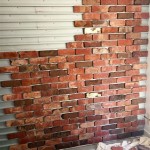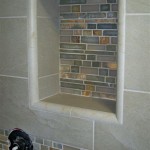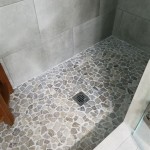How to Tile a Concrete Patio: A Comprehensive Guide
Transforming a plain concrete patio into a vibrant and inviting outdoor space is achievable with the right preparation and technique. Tiling a concrete patio offers a durable, aesthetically pleasing, and relatively straightforward DIY project for homeowners seeking to enhance their outdoor living area.
1. Assessing the Concrete Surface
Before beginning the tiling process, a thorough assessment of the existing concrete surface is crucial. This assessment will determine the necessary preparatory steps and ensure the long-term success of the tile installation.
Check for cracks, spalling, or any signs of deterioration. Minor cracks can often be repaired with concrete patching compound. Larger cracks or structural issues may require professional attention. Ensure the concrete is clean and free of any debris, oil stains, or previous coatings. A pressure washer can be effective in removing stubborn dirt and grime. Verify that the concrete surface is level. Significant unevenness will require leveling compound before tile installation.
2. Gathering the Necessary Tools and Materials
Proper preparation involves gathering all necessary tools and materials upfront. This streamlines the process and prevents interruptions during the project.
Essential tools include a notched trowel, rubber grout float, tile spacers, tile cutter or wet saw, safety glasses, gloves, and a bucket. Materials required are thin-set mortar, grout, sealant, tiles, and potentially backer board depending on the condition and location of the concrete slab.
3. Preparing the Concrete Surface
Preparing the concrete is essential for proper adhesion of the tile. This step ensures a lasting and stable tile installation.
Clean the concrete thoroughly using a degreaser and a stiff brush. Rinse thoroughly and allow the concrete to dry completely. If the concrete surface is particularly porous, apply a concrete primer to improve adhesion. Repair any cracks or imperfections with concrete patching compound following the manufacturer's instructions.
4. Applying the Thin-Set Mortar
Applying the thin-set mortar correctly is critical for a strong bond between the tiles and the concrete surface.
Following the manufacturer's instructions, mix the thin-set mortar to the proper consistency. Using a notched trowel, apply a thin layer of mortar to the concrete surface, covering an area slightly larger than the size of the tile being laid. The size and depth of the notches on the trowel will depend on the size and type of tile being used. Consult the tile manufacturer's recommendations for the appropriate trowel size.
5. Laying the Tiles
Precise tile placement ensures a professional and visually appealing finished product.
Carefully place the first tile into the thin-set mortar, pressing firmly to ensure full contact. Insert tile spacers between each tile to maintain consistent grout lines. Continue laying tiles in a systematic manner, working in small sections. Periodically check the alignment and spacing of the tiles to maintain a straight and even surface.
6. Cutting Tiles for Edges and Corners
Cutting tiles accurately is essential for a clean and professional finish around edges, corners, and obstacles.
Measure and mark the tiles accurately before cutting. Use a tile cutter or wet saw for precise cuts. For curved or intricate cuts, a tile nipper can be used. Test fit the cut tiles before applying mortar to ensure a proper fit.
7. Grouting the Tiles
Grouting fills the spaces between the tiles, providing stability and a finished appearance.
After the thin-set mortar has cured for the recommended time (typically 24 hours), remove the tile spacers. Mix the grout according to the manufacturer's instructions. Apply the grout using a rubber grout float, pressing it firmly into the joints at a 45-degree angle. Remove excess grout with the edge of the float. After the grout has partially dried, use a damp sponge to clean the tile surface, removing any remaining grout haze.
8. Sealing the Grout
Sealing the grout protects it from staining and moisture, prolonging its lifespan and maintaining its appearance.
Once the grout has fully cured (typically 72 hours), apply a grout sealant following the manufacturer's instructions. This will help prevent staining and water penetration, ensuring the longevity of the grout and the overall tile installation.
9. Allowing for Proper Curing Time
Allowing adequate curing time for both the thin-set mortar and the grout is crucial for achieving maximum strength and durability.
Avoid heavy traffic on the newly tiled patio for the recommended curing time specified by the manufacturers of the thin-set mortar and grout. This will ensure a strong and long-lasting tile installation.

How To Install Tile Over An Existing Concrete Patio The Rta

Concrete Patio Transformation 7 Steps To Diy A New Outdoor Oasis

Concrete Patio Transformation 7 Steps To Diy A New Outdoor Oasis

Concrete Patio Transformation 7 Steps To Diy A New Outdoor Oasis
:max_bytes(150000):strip_icc()/can-you-install-tile-directly-on-concrete-1822600-04-458f7bb6c78348c1835cf8054ef36553.jpg?strip=all)
How To Install Tile Over Concrete

Tiling Over A Ed Concrete Slab Fine Homebuilding

Concrete Patio Transformation 7 Steps To Diy A New Outdoor Oasis

How To Create Faux Tile Look On Concrete Patio Southern Hospitality
Prepping For Outdoor Patio Tile Installation Jlc

How To Create Faux Tile Look On Concrete Patio Southern Hospitality
Related Posts








